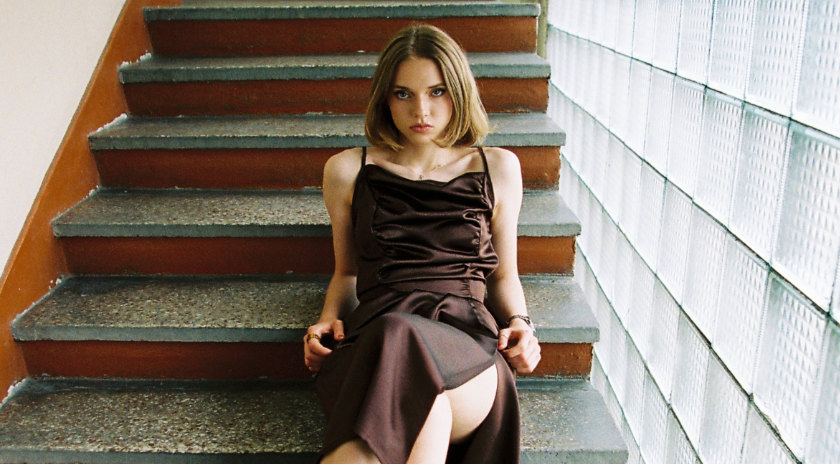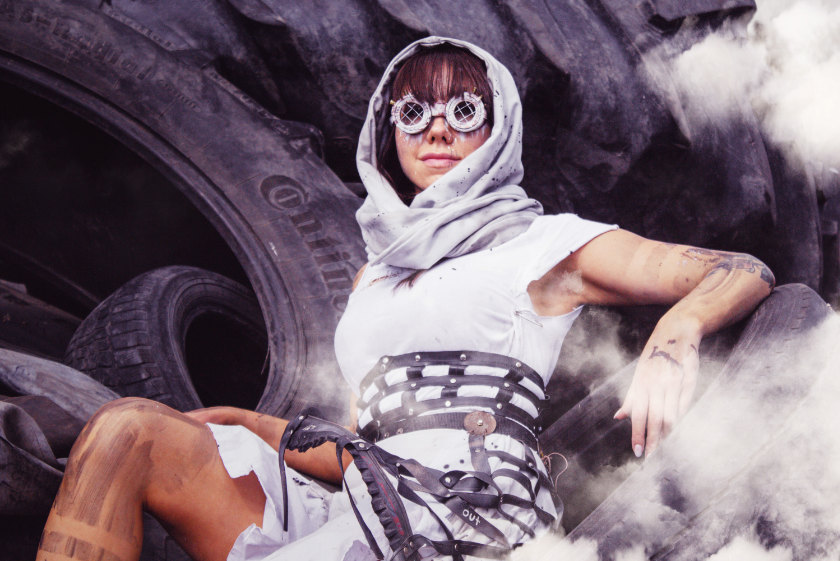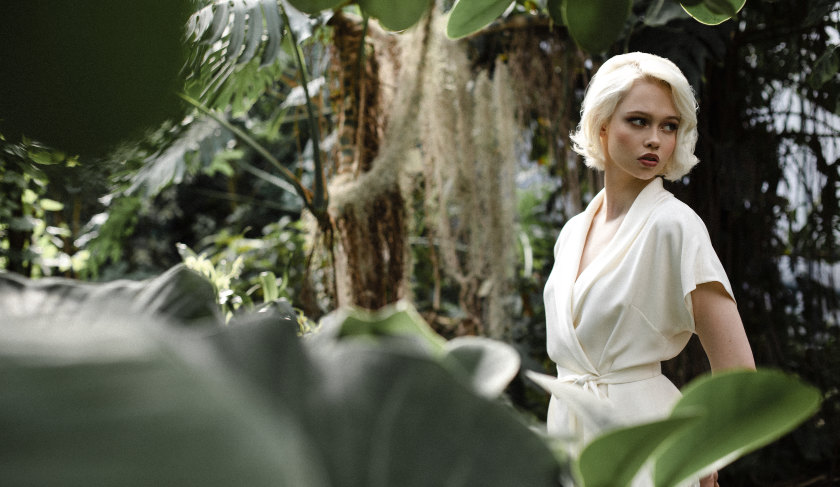
Lüllepop’s Hélène jumpsuit, photographed at the Louvre.
Fashion
Jack Yan interviews Lüllepop’s Cathleen Reinheckel, who has embarked on a mission to free latex from its fetishist context and to show just what elegant fashions the renewable and largely sustainable material can shape
From issue 49 of Lucire


André Gawanka


Marc Lamey
Above, from top: Team Lüllepop: photographer André Gawanka, Emely, and designer Cathleen Reinheckel. Marianne models the Smeralda bodysuit and Ira cape. Lilly Pietry wears the Jade bodysuit. Magaux Avilaponce in the Mermaid design.
In a more eco-conscious world, one would think latex would be used more widely in fashion. It’s renewable and sustainable as it comes from the rubber tree, and its extraction done by hand. It is free of solvents, CFCs and carcinogenic chemical plasticizers—and it is certainly not PVC, which some mistake it for.
As a material, it’s derived from a milky fluid that comes out of 20,000 plant species after their tissue is injured. To protect the plant, it coagulates when exposed to air, hardening into a waterproof mass. By making incisions into the bark of a rubber tree (a process called rubber tapping), the fluid is collected. The tree does not need to be cut down and rubber plantations have a lower environmental impact than oil palm or coffee.
It’s by no means a new material: natural rubber was used in Mesoamerica in 1600 BC, and in the west, it was adopted for protective clothing. By the 19th century it was more mainstream: the Mackintosh raincoat appeared in 1824, but in ensuing decades its erotic appeal led to rubber garments being considered taboo. The catsuit appeared in the late 1950s, designed by John Sutcliffe, and one outfit inspired by the design came to prominence in the ’60s, donned by Honor Blackman and Diana Rigg in The Avengers. Arguably this remains its most iconic appearance in mainstream television.
Vivienne Westwood and Malcolm McLaren’s boutique, Sex, stocked latex garments, which were popular among the youth subculture of the 1970s, finding its way into clubs in the 1980s. But it was the 1990s that saw it return and then appear on the silver screen: Michelle Pfeiffer in Batman Returns, the big-screen adaptation of The Avengers with Uma Thurman, and Carrie-Ann Moss in The Matrix. The major labels followed, and it continued to have its supporters: Lady Gaga, Miley Cyrus, and Kim Kardashian among them.
Despite latex coming back into acceptance, few designers use it as their core material, with the exception of Lüllepop, the label founded in Berlin in 2009 by Cathleen Reinheckel, and developed by her with husband, photographer André Gawanka. Reinheckel takes latex further than most, applying modern techniques to it, such as laser-cutting; she also works with embossing and knitting it. Each item is hand-made at her studio in the Niederlausitzer Landrücken.
Born in Freiberg, Reinheckel studied textile and clothing technology at the BSZ e.o. Plauen, where she gained her basic knowledge in pattern construction and design, then the Hochschule für Technik und Wirtschaft in Berlin, where she graduated with a fashion design degree. She credits this time for honing her professional skills as well as deepening her passion for fashion and design.
Reinheckel was around 16 or 17 when she became interested in fashion. ‘I loved going out dancing, but I often lacked clothes that were both figure-hugging and offered sufficient freedom of movement,’ she recalls. ‘Out of this need, I started sewing clothes for myself and my friends from extravagant and bi-elastic fabrics. During my training in Plauen, I had already learned the art of pattern construction, which helped me to realize my creative ideas. Even back then, my outfits were characterized by their extravagance and eye-catching nature, with lots of ingenious details and exciting cuts.’
Latex came by chance during her training: ‘I was first confronted with this fascinating material during an internship with a renowned latex designer. A friend had recommended the label to me, knowing that I had a strong interest in bi-elastic materials.’
She continues, ‘When I got to know latex, I immediately realized the incredible potential of this material. Unlike other bi-elastic materials, latex has the unique property of returning completely to its original state after stretching. This permanent elasticity allows the outfits to conform to the body whether you are sitting, standing or moving.
‘In addition, depending on its thickness, latex offers an ever-increasing body-shaping effect. For example, it is possible to shape a slim waist without restricting the wearer’s freedom of movement. As latex seams are glued flat and not sewn, there are no irritating seams for the skin, even with tight-fitting clothing.
‘I was also intrigued by the fact that the latex we use is a natural product. As a nature-loving person, I was particularly fascinated by this aspect. Using a natural material in my designs not only contributes to sustainability, but also gives the pieces a special authenticity and connection to nature.’
She then hit on the idea of combining latex with textile fabrics, which she says opened up ‘endless creative possibilities, and inspired me to take my designs to a whole new level.’
Reinheckel had an eye on being self-employed, even while she was studying, and knew she had to work in a creative profession. She had even integrated the business plan for Lüllepop into her thesis, and after graduating, she was ready to launch the brand.
The brand name is the surname of a close friend of hers. ‘I have always been fascinated by this name and its sonorous presence has never let me go. It was as if it opened a secret door to a world of creativity and personality and captured the essence of my designs: innovative, playful and unique.’
And there was only one place where she felt she could launch her brand: Berlin. ‘In this city, cosmopolitanism and individuality know no bounds. Towards the end of my studies, I met my husband, André Gawanka, who was a photographer specializing in clothing. Since then, our collaboration has been extremely enriching for our creative development. Especially in our photo campaigns, which have been published in various magazines worldwide, we can give free rein to our creativity.’
continued below


Susann Loessin

Benedikt Ernst
André Gawanka
Above, from top: Ginerva top, Alyssa pants, and Matilda ring, modelled by Lilly Pietry.
Ginerva top and Rabea pants, modelled by Alina Sophia.
Lucia skirt, Emele blouse, modelled by Redsky.
The Riccarda skirt, Romina top, and Sohi earrings (laser-cut from latex), modelled by Jane Shoe (and friend).
In 2014, they headed to Niederlausitz (Lower Lusatia), which Reinheckel describes as ‘picturesque’, affording them more opportunities. ‘With plenty of space and inspiration from nature, we create photo sets that express the spirit of our fashion even more intensely. We can also realize our artistic visions through various projects with different creatives worldwide.’
She recognizes that latex has a history with fetishes, and a major goal of her work is to show that the material ‘has much more to offer than just tight catsuits and fetish-related clothing.’
She says, ‘My inspiration comes from a passion for challenge and a relentless drive to push the boundaries of what is possible with latex. The versatility of this material is simply fascinating and I love experimenting and discovering what unique creations I can make with it.’
Among those creations are her knitted latex outfits. The idea that came to her through her mother, who Reinheckel describes as a passionate knitter. ‘She taught me this fascinating craft when I was a child. It was only natural that I wanted to try it with latex, too. But the challenges were enormous. The mere fact that there is no endless latex knitting thread and that the material is also stretchy makes producing the basic material for knitting extremely time-consuming.
‘Also, the industrial knitting of latex is not possible due to its nature, so the production is always 100 per cent handmade. It is easy to imagine the immense effort that goes into every piece of knitted latex, from sourcing the material to manufacturing.’
The knitted latex is soft and lively, and actually easy to put on, unlike the second-skin nature of some of the more body-hugging designs. But Reinheckel stresses that even those, once put on, do not stick or get in the way. ‘It provides a firm hold, almost like a loving embrace, and gives the skin a feeling of security and comfort.’
For trickier garments, liquid dressing aids and powders can be applied, though she says these are usually unnecessary for tailored garments. Also, the thicker the latex, the harder it is to put on, but the greater the shaping effect.
The possibilities, says Reinheckel, are endless, with accessories, coats and more applications for this versatile and sustainable material.
Introducing other subtle colours, such as burgundy and champagne, is part of her effort to distance the material from its fetishist context. Using chiffon and lace helps soften its æsthetic and brings greater elegance to it, she says.
Her latex is also laser-cut, and Lüllepop contracts a friend of hers to do the job, which ensures quality control. After laser-cutting, they process the latex further in the studio. ‘We attach great importance to the fact that all stages of production, from design to manufacture, are carried out by hand in our studio in Crinitz.’
The next step for Lüllepop is to focus more on individuality and exclusivity. ‘We will focus more on producing unique one-of-a-kind pieces and customized creations for our valued customers. We want to delve deep into the needs and desires of our customers to create their personal style identity,’ Reinheckel forecasts.
‘Our vision is not just to make clothes, but to create identities—every material, every detail should reflect the uniqueness and personality of our customers. We want our customers to not only feel beautiful in their custom-made Lüllepop garments, but to feel special—something created exclusively for them that highlights their individuality.’ •

Tim Hamann

Reinhard Scheuregger

André Gawanka
Above, from top: Luan slipover, modelled by Yasmin Faith. Letizia dress. Eleonora blouse, Lucia skirt, and Georgia belt.
Jack Yan is founder and publisher of Lucire.
Related articles hand-picked by our editors

Searching, for the brave
Pour les courageuses
The poetry of Lithuania, its traumatic past, and the notion of community come together for Arūnė Jurevičiūtė’s label, Searching. Jack Yan interviews her
La poésie de la Lituanie, son passé traumatique et la notion de communauté se rejoignent pour le label d’Arūnė Jurevičiūtė, Searching. Jack Yan l’interviewe
Photographed by/photographié par Marija Mireckaite
From issue 46 of Lucire and the October 2022 issue of Lucire KSA
Dans le 46e numéro de Lucire et le numéro de l’octobre 2022 de Lucire KSA

One with her community
Un avec sa communauté
Wiola Sychowska discovered her love of post-apocalyptic fashion upon attending a festival. Today, she designs for the community who shares her love, as well as cyberpunk and alternative fashion—all while being sustainable with an eye on zero-waste. Jack Yan interviews her
Wiola Sychowska a découvert son amour de la mode post-apocalyptique en assistant à un festival. Aujourd’hui, elle crée pour la communauté qui partage son amour, ainsi que pour la mode cyberpunk et alternative – tout en étant durable, avec un objectif de zéro déchet. Jack Yan l’interviewe
First published in the December 2022 issue of Lucire KSA
Dans le numéro du décembre 2022 de Lucire KSA

Thoughtful and timeless
Réfléchi et intemporel
Slow fashion, elegance, and exceptional quality come together in Estonia with Marimo, the label founded by designer Mariliis Pikkar. Jack Yan interviews her
Slow fashion, élégance et qualité exceptionnelle sont réunis en Estonie avec Marimo, le label fondé par la créatrice Mariliis Pikkar, interviewée par Jack Yan
Photographed by/photographié par Julia Astok
From issue 45 of Lucire
Dans le 45e numéro de Lucire